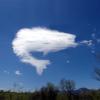Hmmmm... Not sure. I can't see the bass usually, so it's tough to say. I think there is "more to" a deer than a bass. Deer can definitely know they are being hunted. Not so sure bass can. I could be wrong but I suspect the bass Tom mentions in Lembeck's study that used a protected area during fishing season, may simply have coincidently used that closed area as its summer home range. If it was avoiding fisherman, it would probably have been bc it was a shy individual.
I can say though, that I agree with Tommy that mature deer are, or can be, WAY more capable at evading hunters than younger ones. Among many such experiences, I'll describe a big muley buck that I watched through binocs from my front deck a couple years ago. It was fall, pre-rut, but he was keeping track of a group of does. All the other deer, including some smaller yearling bucks, were quite active, moving about, and quite noticeable, for deer. But when that buck materialized, he moved very little. He stood statue still between movements, for up to 20min at a time. I thought, if I were still-hunting that mountain side, his "patience" would have had me pegged. Big bucks are particularly vulnerable to mountain lions here, so I can understand his caution. Big whitetails too, can be very difficult to see too. And, it's not just the bucks. There was a doe I got to know during a season, years ago, who, once she saw me for what I was, she could recognize me, instantly, over surprising distances, anywhere: Inside a blind, even melded into an old tractor that had been in the woods for years. She simply knew who I was.
Can older bass do this? It's suggested that bigger bass see better than smaller ones, bc their eyes gain more vision cells as they grow. And, cognitively, they have more experience. And, it's known that bass can become much more difficult to catch after they gain experience with fishing. But, can they put 2 and 2 together, like that doe appeared to be able to do? At this point, I kind of doubt it.









